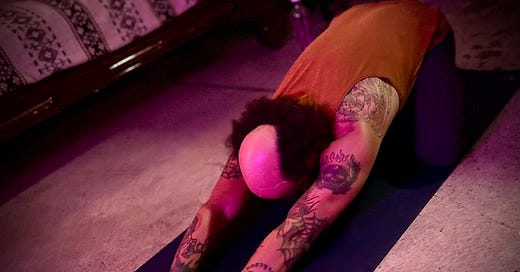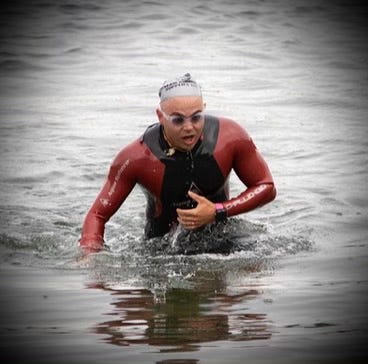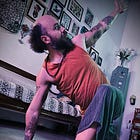Breath, the Nervous System, and the Practice That Holds It All Together
A post for the ones who feel too much, think too fast, or carry more than they show.
Breathing in, breathing out.
I’m laid out in Child’s Pose, forehead resting heavy on the mat.
Letting go of the week.
Exhaling what I’ve been carrying — tension, thoughts, pressure, all of it.
In these moments, I let myself surrender.
To something higher.
To what I really am underneath all the noise.
Yoga gets misunderstood a lot.
People see the stretching, the playlists, the soft lighting — but miss the deeper part.
The actual practice.
That’s what I want to talk about here — what’s really going on inside a pose, and how that ties into the nervous system, neurodivergence, and how we hold stress.
This isn’t “spiritual” like some floating idea.
It’s spiritual because it brings you face to face with your own experience.
Your breath. Your patterns. Your will.
Just like learning how your nervous system works helps you handle stress better,
yoga gives you tools to meet life differently.
Not perfectly — but with more space.
More breath.
Let’s start simple.
When you’re in a pose like Child’s Pose — knees open, arms stretched out, spine releasing — you’re not just “doing a stretch.”
You’re letting go.
You’re slowing your breath down, which calms the nervous system.
You’re letting the exhale lead. That tells your body it’s safe to rest.
The longer you hold, the deeper it gets.
You start to feel the fascia open. Blood circulation improves.
The tension in the low back starts to let go.
The hips maybe resist a bit — that’s okay.
This is the work.
This is prana — your life force — actually moving.
Not an idea. Not a theory.
Just you, on the mat, breathing.
So what is your nervous system, after all?
It’s not some abstract thing.
It’s you.
It’s how your body handles the world before you even think about it.
It’s what decides whether you can rest… or whether everything feels like a threat.
And yoga?
It doesn’t magically fix everything overnight.
But slowly, breath by breath, it retrains the system.
The way we breathe shifts the way our nervous system behaves.
It changes the way we walk, the way we speak, the way we handle the moment we’re in.
Think back to a time when you were anxious.
Tense jaw. Racing thoughts.
Your breath gets stuck in your chest.
It’s fast, shallow — maybe you don’t even realize you’re barely breathing.
That’s your sympathetic system — the fight-or-flight part — taking over.
Your body thinks you’re in danger, even if you’re not.
But the breath is your bridge.
When you start to slow it down — lengthen the exhale, feel the body again — everything starts to shift.
That’s when you move from survival mode into presence.
I remember during a half Ironman I was doing — swimming in a cold lake, adrenaline high, breath short — I saw a canoe float by and immediately had a flashback to a childhood boating accident.
Right there in the middle of the race, I froze.
My heart pounded. My breath locked. I felt panic creep in.
But then I remembered: just breathe.
I took a slow inhale. A longer exhale.
And something in me returned.
My heart didn’t stop racing right away — but my mind came back.
I could feel the water again.
I could feel myself again.
That was my practice, showing up when I needed it.
That was yoga — not as a pose, but as nervous system regulation in the middle of real life.
When I breathed like that, I was speaking directly to my vagus nerve — the part of me that says “you’re safe now.”
That breath told my body the emergency had passed.
And the rest of me followed.
I finished that race with my breath as my anchor the whole way through.
So what’s the science around this?
Simple: your breath and nervous system are directly linked.
The way you breathe tells your body what kind of state it should be in.
If your breath is fast and shallow, your system prepares for danger.
If your breath is long and slow, your system starts to relax.
Breathing out slowly activates something called the vagus nerve — it’s like a reset switch.
It helps bring your heart rate down, calms the brain, and tells your body, “You’re okay.”
That’s why one deep breath can shift everything.
It’s not just a nice idea — it’s real, physical change in your body.
Yoga works because it uses this over and over again.
Breathe. Move. Feel. Pause.
And through that, your system starts to learn a new rhythm.
Even just lying in Child’s Pose, if you’re breathing deeply, your body is getting the message that it’s safe to rest.
That matters, especially if you’re someone who’s always on edge, always scanning, always holding tension without realizing it.
That’s all nervous system stuff.
And yoga helps you unlearn that survival state — one breath at a time.
And here’s the bonus that doesn’t get talked about enough:
When you breathe and hold a pose like Child’s Pose — or any longer-held shape — you’re not just calming the nervous system.
You’re also giving your fascial tissue time to release.
Fascia is the connective web that wraps around your muscles, organs, everything.
It holds memory. Tension. Stress. Even trauma.
And it doesn’t open up with quick movement — it needs time. Stillness. Breath.
That’s why slower practices hit different.
You stay, you breathe, and layer by layer, the tissue softens.
Circulation improves. Space opens.
You might even feel emotion rise up — that’s part of the release.
So now you’re not just calming your system mentally —
you’re clearing space physically.
Making room in your body to feel safe again.
That’s the real practice.
Not just stretching, not just chilling out —
but rewiring the whole system from the inside.
Now you’re going deeper.
You’re not just stretching, not just breathing — you’re calming your entire system.
That alone has a strong mental benefit.
As you slow the breath, cortisol levels drop.
Your nervous system shifts out of survival mode.
Your brain starts to balance out — dopamine, serotonin — everything begins to regulate.
This is huge for those of us whose brains work a little differently.
Whether it’s anxiety, ADHD, autism, trauma, or just the weight of constant pressure —
this kind of regulation isn’t just helpful, it’s essential.
And for me, the practice deepens even more when I bring in mantra.
Simple, powerful sound.
Even just moving from Child’s Pose into a comfortable seat, and letting the sound of Om ride the breath — something shifts.
The breath becomes a focus point.
The sound becomes a guide.
And the mind — even if just for a moment — quiets.
Sometimes that’s all we need.
Just a few slow breaths between tasks.
A small pause between the chaos.
A moment to come back to ourselves.
Because that’s what this is really about —
remembering your centre.
Your own internal rhythm.
Your own calm under the noise.
As holistic and modern sciences continue to come together,
we see what yogis have known for thousands of years:
this is a complete system.
A system that improves physical health, mental clarity, and spiritual connection.
And yeah — more and more studies are being done. There’s data out there, and that’s great.
But honestly?
The best study is the one you do on yourself.
Try it.
Sit for a minute.
Breathe in slow.
Exhale even slower.
No fixing. No forcing.
Just being.
That alone can shift your whole state of being.
Because the truth is —
you’ve always been whole.
All you’re doing now
is remembering that.
Journaling Your Practice
It’s always good to journal your thoughts and realizations.
Not because you’re trying to get it “right,” but because it helps you see yourself clearly.
It tracks your rhythm. Your progress. Your own way of showing up.
You don’t need fancy tools.
Let it be old school.
Pen, paper, presence.
Ask yourself with curiosity.
Ask yourself why.
And if you’re working with an AI assistant, try sharing something simple like:
“I experienced a shift in energy…” or “ During my yoga/meditation practice this thought coming back…”
Describe what came up. The breath. The body. The stillness.
Let the system reflect it back — sometimes that reflection helps you see what you already know.
This is your practice.
Keep listening.
✨ If this post resonated, you can:
Explore more at redshanti.com
Support the work, check out manuals/papers in the shop or leave a tip at ko-fi.com/redshanti
Or simply share this post with someone who needs a breath right now
Rooted in rhythm,
Red Shanti
Last Saturday
Last Wednesday
From the archives









I found Yin yoga during the pandemic and it has provided peace, alignment, and flexibility!
This piece is both science and soul—thank you for writing it.